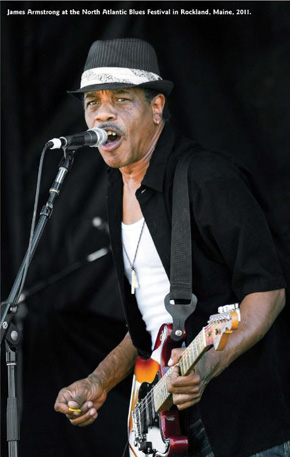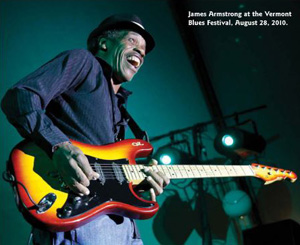James Armstrong’s career is back in high gear. His latest CD, Blues Been Good to Me, was released in late 2017 and has garnered rave reviews. He wrote eight of the ten songs and the two he borrowed, he makes his own.
Not long before recording, Armstrong had been on the road for 70 shows in four months, including a European tour. And when he got back to the States, he turned around and flew to Spain to play for two weeks. The gigs keep coming and he is thrilled.
With this third CD for Texas-based Catfood Records, he shares production duties with music veterans Johnny Rawls and Jim Gaines. A man who likes to be prepared, Armstrong was so busy before recording, he did not have much time to get ready—he even had to finish writing two of the songs at the sessions. As it turns out, he is more than pleased with the results.
Perhaps most importantly, Armstrong says that Gaines pushed him past the injuries that have plagued him from the knife attack he sustained 20 years ago, when both he and his son were seriously injured. It has been a very long, tough road and he is ready for this resurgence. “Jim pushing me to play more literally changed my whole perspective. He said to ‘just try.’ Now, I’m doing more stuff on the guitar than I have in 20 years.
“On the spiritual side of things, I had to let some stuff go. I’m a paralyzed, handicapped guitar player—a two-fingered guitar man. My hand hurts and I can’t do everything I used to do. I asked for help and something happened.
“I’m lucky. I’m still working quite a bit. We have the van and we’re gonna get in it and travel 10,000 miles soon. That’s pretty amazing.”
Armstrong’s Guitar Angels, the title song on his 2014 release, chronicles his struggle and has become his legend. He says that, for a time, he did not want to play guitar, but he just couldn’t let it go. The song declares, “Don’t give up on yourself.” And, if you get him talking, he will tell you all about those angels who have helped him along the way.
Armstrong, a Los Angeles native, is just hitting 60. Today, he lives with his wife, Alice, in Springfield, Illinois. He has come a long way from his discovery by HighTone Records—the same label that launched the careers of Robert Cray and Joe Louis Walker not long before Armstrong came along.
Armstrong’s history in music goes way back, and not all of it is in the blues. Though he started on the drums, and then saxophone, it was the guitar that hooked him. He picked it up at seven or eight. As he puts it, “As far as I can remember, it’s just guitar my whole life.”
His mom, who moved away when he was very young, was a singer. Armstrong grew up with his jazz guitar–playing dad, James Armstrong Sr. His father had a chalkboard ready for music classes when his son got home from school, and he introduced him to some of his guitar-wielding friends when they came to visit, or when father and son headed out to their gigs and hung out in the green room.
At age 12 Armstrong was in a local band playing parties. Then he fell hard for Jimi Hendrix and the Allman Brothers and says he even got Hendrix’s vocal style down pat.
The opportunity to play with a country band took him out of high school just before graduation. He was on the road for six weeks at age 17. Next up were a few rock bands, including blues-rockers Mama Roo, who recorded for Crescendo Records in 1990. Armstrong played guitar and sang in the band, and on the recording, but was not the bandleader. Once he finally began to front blues bands he never looked back.
Mississippi to Los Angeles transplant Smokey Wilson, the too-little-known songwriter and guitarist Sam Taylor, Big Joe Turner and former junior high friend Coco Montoya and Montoya’s musical boss, Albert Collins, all played some role in Armstrong’s development as a bluesman, as did acoustic player Doug MacLeod. Armstrong befriended, backed them or just listened to and followed their advice. He readily credits everyone who has helped him along the way.
Sleeping with a Stranger announced his arrival on the international blues scene in 1994. HighTone had discovered him while he was between bands, and he had to hire musicians for his club audition. The label encouraged him to lose the Hendrix vocal influence and to just be himself.
The violent knife attack, which could have ended his career, happened not long after the CD was released and he was just making a name for himself. An intruder broke into his apartment and attacked Armstrong and his son, James, who was thrown from a balcony and badly injured. He is now in his 20s and doing well. Armstrong proudly reports that his son has recently begun playing some guitar and piano.
With some time out to recuperate from his injuries, Armstrong thought his musical career was over. But, with a lot of support, he eventually got back to playing and recording. The aptly named second CD, Dark Night, was released in 1998, also on HighTone. He says the label cared about him and stuck with him. Walker and MacLeod handled most of the guitar work and others, including friend Mike Ross who later produced Armstrong’s first release for Catfood, Blues at the Border, played guitar for him at gigs. Given his limitations, Armstrong also taught himself to play with a slide.
He reflects on the many benefits held for him by friends and how hard they pushed him to keep playing, though doctors only gave him a 50-50 chance of regaining the use of his hand. He says that Walker, Montoya and MacLeod found creative ways to encourage him—sometimes handing him a guitar on stage and other times just urging him on.
Today, Armstrong’s performances feature stinging guitar, skilled slide work and his smooth, unforced vocals. He connects easily with the audience, making eye contact, and he often introduces his songs with a story.
Armstrong has now released a total of six CDs under his own name and the pace is accelerating, as are calls for him to appear at clubs and festivals. He has been working the States, Europe, Scandinavia, Asia and the Middle East. Armstrong says that he wants to keep at it and try new things, including playing some solo acoustic sets.
He has always loved playing acoustic guitar but had let it go, finding it too hard to handle with his injuries. “I’m going to go out and get one and do some woodshedding. I’d like to do a solo thing. I’m gonna keep working with the band but I like to tell stories and it would be fun to [play some acoustic gigs].”
He is also interested in producing. “I just worked with a local woman—I produced her record. I made a little label called Guitar Angels Records and I’d like to start doing some more producing. I’m going to build a studio—we have a nice basement.”
With the support of his guitar angels and a lot of woodshedding, Armstrong has emerged from an incredibly tough time as a skilled, deep blues veteran. With his immense appreciation that he can still perform, growing guitar prowess, soulful vocals and original songs, it is no wonder why he is a fan favorite.
This article by Scott M. Bock appears in the Living Blues Magazine, #285, December 2018/January 2019

